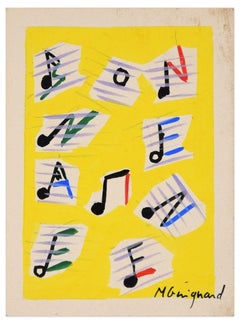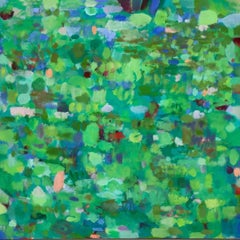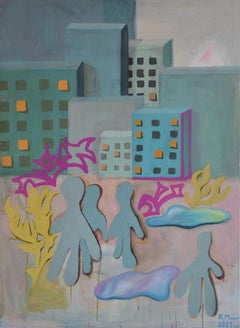Michel Guignard Abstract Paintings
to
1
1
1
1
Overall Height
to
Overall Width
to
1
1
3
556
519
319
281
1
1
Artist: Michel Guignard
Composition with Letters and Notes - Original Tempera by M. Guignard - Late 1900
By Michel Guignard
Located in Roma, IT
Composition with Letters and Notes is a small yet gracious tempera on cardboard, realized by the French artist Michel Guignard. The artwork is in excellent conditions, except for a t...
Category
Late 20th Century Contemporary Michel Guignard Abstract Paintings
Materials
Tempera
Related Items
o.T. (kleines Feld)
Located in Berlin, DE
Jürgen Reichert - Maler
Freischaffender Künstler, Farbflächenmalerei, lebt und arbeitet in Berlin.
o.T.
2015
Eitempera auf Leinwand
120 x 120 cm
Jürgen Reichert, 1953 in Mannheim g...
Category
2010s Abstract Michel Guignard Abstract Paintings
Materials
Canvas, Egg Tempera
What You All Want ??? - Contemporary Figurative Painting, Polish Young Art
Located in Salzburg, AT
Kasia Mazur is a very young artist, she is still studying painting at the Academy of Fine Arts in Gdansk, where she also lives. She has already had exhibit...
Category
2010s Contemporary Michel Guignard Abstract Paintings
Materials
Cotton Canvas, Oil, Acrylic, Tempera
H 39.38 in W 28.75 in D 0.79 in
White Dawn
By John Little
Located in Austin, TX
Egg emulsion on fiberglass. Signed and dated upper left and verso; titled verso.
49 x 48 in.
49.75 x 49 in. (framed)
Custom framed in hickory.
Provenance
Albright-Knox Art Gallery, Buffalo, NY
Born in Alabama, John Little attended the Buffalo (NY) Fine Arts Academy as a teenager, until 1927. Soon after, he moved to New York where he began operatic vocal training and opened what would become a very successful textile business designing fabric and wallpaper.
In 1933, he enrolled at the Art Students League under the tutelage of George Grosz. Little’s early work consisted predominantly of landscapes, until 1937, when he began studying under Hans Hofmann and his work naturally shifted toward abstraction. During his time with Hofmann, he with artists such as Lee Krasner, George McNeil, Gerome Kamrowski, Giorgio Cavallon...
Category
1960s Abstract Expressionist Michel Guignard Abstract Paintings
Materials
Fiberglass, Egg Tempera
Ceremonial Dancers oil and tempera painting by Julio De Diego
By Julio de Diego
Located in Hudson, NY
Artwork measures 48" x 30" and framed 56 ¼" x 38 ¼" x 3"
Provenance:
John Heller Gallery, NYC, circa 1975 (label verso)
The artist's daughter
Corbino Galleries, Sarasota, FL (1990)...
Category
1940s Modern Michel Guignard Abstract Paintings
Materials
Masonite, Oil, Tempera
The Three Emperors, Futuristic painting triptych as a Byōbu-ē folding screen
By Konstantinos Papamichalopoulos
Located in Dallas, TX
The Three Emperors is a triptych, which Papamichalopoulos has created a Byōbu-ē folding screen. Each panel measures 150x40 cm / 59 x 16 inches.
The piece is created using ink, egg-...
Category
2010s Contemporary Michel Guignard Abstract Paintings
Materials
Gold Leaf
H 59.06 in W 47.25 in D 1.19 in
"We Recognize the Impermanence of Life Yet we feel the Attachments..." painting
Located in Phoenix, AZ
Carrie Marill
"We Recognize the Impermanence of Life... Yet we feel the Attachments... This is what gives our Lives those Special Textures...", 2017-2021
egg tempera and acrylic on l...
Category
2010s Contemporary Michel Guignard Abstract Paintings
Materials
Linen, Acrylic, Egg Tempera
H 21.5 in W 21.25 in D 7 in
St. Atomic oil and tempera painting by Julio de Diego
By Julio de Diego
Located in Hudson, NY
Julio De Diego’s Atomic Series paintings made an extraordinary statement regarding the shock and fear that accompanied the dawn of the nuclear age. In the artist’s own words, “Scientists were working secretly to develop formidable powers taken from the mysterious depths of the earth - with the power to make the earth useless! Then, the EXPLOSION! . . . we entered the Atomic Age, and from there the neo-Atomic war begins. Explosions fell everywhere and man kept on fighting, discovering he could fight without flesh.”
To execute these works, De Diego developed a technique of using tempera underpainting before applying layer upon layer of pigmented oil glazes. The result is paintings with surfaces which were described as “bonelike” in quality. The forms seem to float freely, creating a three-dimensional visual effect. In the 1954 book The Modern Renaissance in American Art, author Ralph Pearson summarizes the series as “a fantastic interpretation of a weighty theme. Perhaps it is well to let fantasy and irony appear to lighten the devastating impact. By inverse action, they may in fact increase its weight.”
Exhibited
1950 University of Illinois at Urbana "Contemporary American Painting"
1964 Marion Koogler McNay Art Institute, San Antonio, Texas
This work retains its original frame which measures 54" x 36" x 2".
About this artist: Julio De Diego crafted a formidable persona within the artistic developments and political struggles of his time. The artist characterized his own work as “lyrical,” explaining, “through the years, the surrealists, the social-conscious painters and the others tried to adopt me, but I went my own way, good, bad or indifferent.” [1] His independence manifested early in life when de Diego left his parent’s home in Madrid, Spain, in adolescence following his father’s attempts to curtail his artistic aspirations. At the age of fifteen he held his first exhibition, set up within a gambling casino. He managed to acquire an apprenticeship in a studio producing scenery for Madrid’s operas, but moved from behind the curtains to the stage, trying his hand at acting and performing as an extra in the Ballet Russes’ Petrouchka with Nijinsky. He spent several years in the Spanish army, including a six-month stretch in the Rif War of 1920 in Northern Africa. His artistic career pushed ahead as he set off for Paris and became familiar with modernism’s forays into abstraction, surrealism, and cubism.
The artist arrived in the U.S. in 1924 and settled in Chicago two years later. He established himself with a commission for the decoration of two chapels in St. Gregory’s Church. He also worked in fashion illustration, designed magazine covers and developed a popular laundry bag for the Hotel Sherman. De Diego began exhibiting through the Art Institute of Chicago in 1929, and participated in the annual Chicago Artists Exhibitions, Annual American Exhibitions, and International Water Color Exhibitions. He held a solo exhibition at the Art Institute of Chicago in the summer of 1935. Though the artist’s career was advancing, his family life had deteriorated. In 1932 his first marriage dissolved, and the couple’s young daughter Kiriki was sent to live with friend Paul Hoffman.
De Diego continued to develop his artistic vocabulary with a growing interest in Mexican art. He traveled throughout the country acquainting himself with the works of muralists such as Carlos Merida, and also began a collection of small native artifacts...
Category
1940s American Modern Michel Guignard Abstract Paintings
Materials
Masonite, Oil, Tempera
Journey to the Center of the Earth Illustration
Located in Miami, FL
20th Century Italian Illustrator Gianna Renna depicts a emotionally-charged scene of three men on a raft descending into a fiery abyss. His conception and execution of Jules Verne's ...
Category
1960s Contemporary Michel Guignard Abstract Paintings
Materials
Tempera
The Magician oil and tempera painting by Julio de Diego
By Julio de Diego
Located in Hudson, NY
Julio De Diego’s Atomic Series paintings made an extraordinary statement regarding the shock and fear that accompanied the dawn of the nuclear age. In the artist’s own words, “Scientists were working secretly to develop formidable powers taken from the mysterious depths of the earth - with the power to make the earth useless! Then, the EXPLOSION! . . . we entered the Atomic Age, and from there the neo-Atomic war begins. Explosions fell everywhere and man kept on fighting, discovering he could fight without flesh.”
To execute these works, De Diego developed a technique of using tempera underpainting before applying layer upon layer of pigmented oil glazes. The result is paintings with surfaces which were described as “bonelike” in quality. The forms seem to float freely, creating a three-dimensional visual effect. In the 1954 book The Modern Renaissance in American Art, author Ralph Pearson summarizes the series as “a fantastic interpretation of a weighty theme. Perhaps it is well to let fantasy and irony appear to lighten the devastating impact. By inverse action, they may in fact increase its weight.”
Exhibited
1964 Marion Koogler McNay Art Institute, San Antonio, Texas
This work retains its original frame which measures 54" x 42" x 2"
About this artist: Julio De Diego crafted a formidable persona within the artistic developments and political struggles of his time. The artist characterized his own work as “lyrical,” explaining, “through the years, the surrealists, the social-conscious painters and the others tried to adopt me, but I went my own way, good, bad or indifferent.” [1] His independence manifested early in life when de Diego left his parent’s home in Madrid, Spain, in adolescence following his father’s attempts to curtail his artistic aspirations. At the age of fifteen he held his first exhibition, set up within a gambling casino. He managed to acquire an apprenticeship in a studio producing scenery for Madrid’s operas, but moved from behind the curtains to the stage, trying his hand at acting and performing as an extra in the Ballet Russes’ Petrouchka with Nijinsky. He spent several years in the Spanish army, including a six-month stretch in the Rif War of 1920 in Northern Africa. His artistic career pushed ahead as he set off for Paris and became familiar with modernism’s forays into abstraction, surrealism, and cubism.
The artist arrived in the U.S. in 1924 and settled in Chicago two years later. He established himself with a commission for the decoration of two chapels in St. Gregory’s Church. He also worked in fashion illustration, designed magazine covers and developed a popular laundry bag for the Hotel Sherman. De Diego began exhibiting through the Art Institute of Chicago in 1929, and participated in the annual Chicago Artists Exhibitions, Annual American Exhibitions, and International Water Color Exhibitions. He held a solo exhibition at the Art Institute of Chicago in the summer of 1935. Though the artist’s career was advancing, his family life had deteriorated. In 1932 his first marriage dissolved, and the couple’s young daughter Kiriki was sent to live with friend Paul Hoffman.
De Diego continued to develop his artistic vocabulary with a growing interest in Mexican art. He traveled throughout the country acquainting himself with the works of muralists such as Carlos Merida, and also began a collection of small native artifacts...
Category
1940s American Modern Michel Guignard Abstract Paintings
Materials
Masonite, Oil, Tempera
Wâsakâm ᐋᐧᓴᑳᒼ Along the Shore
Located in Montreal, Quebec
Jason Baerg is a Métis Cree visual artist particularly involved in the transmission of Indigenous knowledge and vocation of taking his artistic practice fur...
Category
2010s Contemporary Michel Guignard Abstract Paintings
Materials
Canvas, Oil, Acrylic, Tempera
Breath of the dragon, egg tempera & wax artwork by Sara Freeman
Located in BUNGENDORE, AU
Contemporary Australian painter Sara Freeman uses multiple layers of egg tempera over a base layer of beeswax to create meaningful, slow art. The linework through the image is made f...
Category
21st Century and Contemporary Contemporary Michel Guignard Abstract Paintings
Materials
Wax, Egg Tempera
H 47.25 in W 31.5 in D 0.79 in
Tempera on paper by Lélia Pissarro titled Infiniment Tendre
By Lelia Pissarro
Located in London, GB
Infiniment Tendre by Lélia Pissarro (b. 1963)
Tempera on paper
14 x 21.5 cm (5 ¹/₂ x 8 ¹/₂ inches)
Signed lower left, Lélia Pissarro
Executed in 2020
Provenance
Studio of the artist...
Category
21st Century and Contemporary Contemporary Michel Guignard Abstract Paintings
Materials
Tempera, Paper
Michel Guignard abstract paintings for sale on 1stDibs.
Find a wide variety of authentic Michel Guignard abstract paintings available for sale on 1stDibs. If you’re browsing the collection of abstract paintings to introduce a pop of color in a neutral corner of your living room or bedroom, you can find work that includes elements of orange and other colors. You can also browse by medium to find art by Michel Guignard in paint, tempera and more. Much of the original work by this artist or collective was created during the 20th century and is mostly associated with the contemporary style. Not every interior allows for large Michel Guignard abstract paintings, so small editions measuring 4 inches across are available. Customers who are interested in this artist might also find the work of Cathryn Jeff, Rosie Phipps, and Brigitte Mathé. Michel Guignard abstract paintings prices can differ depending upon medium, time period and other attributes. On 1stDibs, the price for these items starts at $376 and tops out at $376, while the average work can sell for $376.


